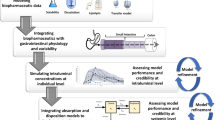Abstract
Recently 2 QSPR-based in silico models were developed in our laboratories to predict the aqueous and non-aqueous solubility of drug-like organic compounds. For the intrinsic aqueous solubility model, a set of 321 structurally diverse drugs was collected from literature for the analysis. For the PEG 400 cosolvent model, experimental data for 122 drugs were obtained by a uniform experimental procedure at 4 volume fractions of PEG 400 in water, 0%, 25%, 50%, and 75%. The drugs used in both models represent a wide range of compounds, with log P values from −5 to 7.5, and molecular weights from 100 to >600 g/mol. Because of the standardized procedure used to collect the cosolvent data and the careful assessment of quality used in obtaining literature data, both data sets have potential value for the scientific community for use in building various models that require experimental solubility data.
Similar content being viewed by others
References
Sweetana S, Akers MJ. Solubility principles and practices for parenteral drug dosage form development.PDA J Pharm Sci Technol. 1996;50:330–342.
Pang SNJ. Final report on the safety assessment of polyethylene glycols (PEGs)-6, −8, −32, −75, −150, −14M, −20M.J Am Coll Toxicol. 1993;12:429–457.
Stouch TR, Kenyon JR, Johnson SR, Chen XQ, Doweyko A, Li Y. In silico ADME/Tox: why models fail.J Comput Aided Mol Des. 2003;17:83–92.
Chen XQ, Cho SJ, Li Y, Venkatesh S. Prediction of aqueous solubility of organic compounds using a quantitative structure-property relationship.J Pharm Sci. 2002;91:1838–1852.
Rytting E, Lentz KA, Chen XQ, Qian F, Venkatesh S. A quantitative structure-property relationship for predicting drug solubility in PEG 400/water cosolvent systems.Pharm Res. 2004;21:237–244.
Fini A, Fazio G, Feroci G. Solubility and solubilization properties of non-steroidal antiinflammatory drugs.Int J Pharm. 1995;126:95–102.
Grant DJW, Higuchi T. Solubility, intermolecular forces, and thermodynamics. In: Saunders WH Jr, ed. Solubility behavior of organic compounds. New York, NY: Wiley; 1990:26.
Pinal R, Yalkowsky SH. Solubility and partitioning. 7. Solubility of barbiturates in water.J Pharm Sci. 1987;76:75–85.
Pogliani L. Modeling purines and pyrimidines with the linear combination of connectivity indices? molecular connectivity “LCCI-MC” method.J Chem Inf Comput Sci. 1996;36:1082–1091.
Hurwitz AR, Liu ST. Determination of aqueous solubility and pKa values of estrogens.J Pharm Sci. 1977;66:624–627.
Mithani SD, Bakatselou V, TenHoor CN, Dressman JB. Estimation of the increase in solubility of drugs as a function of bile salt concentration.Pharm Res. 1996;13:163–167.
Higuchi T, Shih FM, Kimura T, Rytting JH. Solubility determination of barely aqueous-soluble organic solids.J Pharm Sci. 1979;68:1267–1272.
Bowen DB, James KC, Roberts MJ. An investigation of the distribution coefficients of some androgen esters using paper chromatography.J Pharm Pharmacol. 1970;22:518–522.
Herman RA, Vengpedersen P. Quantitative structure pharmacokinetic relationships for systemic drug distribution kinetics not confined to a congeneric series.J Pharm Sci. 1994;83:423–428.
Green AL. Ionization constants and water solubilities of some aminoalkylphenothiazine tranquilizers and related compounds.J Pharm Pharmacol. 1967;19:10–16.
Prankerd RJ, Mckeown RH. Physicochemical properties of barbituric-acid derivatives. 4. Solubilities of 5,5-disubstituted barbituric-acids in water.Int J Pharm. 1994;112:1–15.
Tomida H, Yotsuyanagi T, Ikeda K. Solubilization of steroid hormones by polyoxyethylene lauryl ether.Chem Pharm Bull (Tokyo). 1978;26:2832–2837.
Yalkowsky SH, Valvani SC. Solubility and paritioning I solubility of nonelectrolytes in water.J Pharm Sci. 1980;69:912–922.
Huuskonen J, Salo M, Taskinen J. Aqueous solubility prediction of drugs based on molecular topology and neural network modeling.J Chem Inf Comput Sci. 1998;38:450–456.
The Merck Index. Thirteenth edition. New Jersey: Merck Research Laboratories; 2001.
Analytical Profile of Drug Substances, Vol 1–20. San Diego: Harcourt Brace Jovanovich; 1972–1991.
Analytical Profile of Drug Substances and Excipients, vol 21–30. San Diego: Harcourt Brace Jovanovich; 1992–2004.
Author information
Authors and Affiliations
Corresponding author
Additional information
Published: April 26, 2005.
Rights and permissions
About this article
Cite this article
Rytting, E., Lentz, K.A., Chen, XQ. et al. Aqueous and cosolvent solubility data for drug-like organic compounds. AAPS J 7, 10 (2005). https://doi.org/10.1208/aapsj070110
Received:
Accepted:
DOI: https://doi.org/10.1208/aapsj070110




